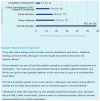Hospice nurses request paediatric-specific educational resources and training programs to improve care for children and families in the community: Qualitative data analysis from a population-level survey
- PMID: 31347446
- PMCID: PMC7074592
- DOI: 10.1177/0269216319866576
Hospice nurses request paediatric-specific educational resources and training programs to improve care for children and families in the community: Qualitative data analysis from a population-level survey
Abstract
Background: Children with serious illness who receive hospice care often interface with nurses who lack training, experience and comfort in the provision of paediatric palliative and hospice care. Hospice nurse preferences for paediatric-specific training are not well known.
Aim: To describe the types of paediatric-specific training received and educational content preferred by hospice nurses.
Design: Population-level dissemination of a cross-sectional survey with qualitative analysis of open-ended survey items.
Setting/participants: Nurses from 71 community-based hospice organizations across 3 states completed the survey.
Results: An open-ended response was provided by 278/551 (50.5%) survey respondents. A total of 55 respondents provided 58 descriptions of prior paediatric-specific training, including a formal 2-day course (n = 36; 65.5%), on-the-job education (n = 13, 23.6%), online training (n = 5, 9.1%), nursing school (n = 2, 3.6%) and paediatric advanced life support courses (n = 2, 3.6%). A total of 67 respondents described 74 hospice-led educational efforts, largely comprised of a 2-day course (n = 39; 54.2%) or provision of written materials (n = 11; 15.3%). A total of 189 respondents described 258 preferences for paediatric-specific training, with nearly half (n = 93; 49.2%) requesting 'any' or 'all' types of education and the remainder requesting education around medication use (n = 48; 25.4%), symptom assessment/management (n = 32; 16.9%), pain assessment/management (n = 28; 14.8), communication (n = 29; 15.3%) and psychosocial assessment/management (n = 28; 14.8).
Conclusions: Hospice nurses self-report inadequate exposure to educational resources and programs, in conjunction with a strong desire for increased paediatric-specific training. Identification of targetable gaps should inform the development of educational resources, policies and other supportive interventions to improve delivery of care to children and families in the community.
Keywords: Paediatrics; education; health care surveys; hospice and palliative care nursing; hospice care; nursing; palliative care; qualitative research.
Conflict of interest statement
Figures



Similar articles
-
Investigation of Modifiable Variables to Increase Hospice Nurse Comfort With Care Provision to Children and Families in the Community: A Population-Level Study Across Tennessee, Mississippi, and Arkansas.J Pain Symptom Manage. 2020 Dec;60(6):1144-1153. doi: 10.1016/j.jpainsymman.2020.06.036. Epub 2020 Jul 2. J Pain Symptom Manage. 2020. PMID: 32622898 Free PMC article.
-
Provision of Palliative and Hospice Care to Children in the Community: A Population Study of Hospice Nurses.J Pain Symptom Manage. 2019 Feb;57(2):241-250. doi: 10.1016/j.jpainsymman.2018.10.509. Epub 2018 Nov 1. J Pain Symptom Manage. 2019. PMID: 30391654
-
Community Hospice Nurses' Perspectives on Needs, Preferences, and Challenges Related to Caring for Children With Serious Illness.JAMA Netw Open. 2021 Oct 1;4(10):e2127457. doi: 10.1001/jamanetworkopen.2021.27457. JAMA Netw Open. 2021. PMID: 34605916 Free PMC article.
-
Pediatric palliative care nursing.Ann Palliat Med. 2019 Feb;8(Suppl 1):S39-S48. doi: 10.21037/apm.2018.06.01. Epub 2018 Jun 25. Ann Palliat Med. 2019. PMID: 30180727 Review.
-
End-of-Life Nursing and Education Consortium Communication Curriculum for Nurses.J Hosp Palliat Nurs. 2019 Apr;21(2):E5-E12. doi: 10.1097/NJH.0000000000000540. J Hosp Palliat Nurs. 2019. PMID: 30676425
Cited by
-
Charting a path to high-quality end-of-life care for children with cancer.Cancer. 2022 Oct;128(20):3586-3592. doi: 10.1002/cncr.34419. Epub 2022 Aug 25. Cancer. 2022. PMID: 36006762 Free PMC article.
-
Pediatric palliative care at home by Home Care Unit: how home nurses feel?Support Care Cancer. 2022 Mar;30(3):2091-2099. doi: 10.1007/s00520-021-06623-w. Epub 2021 Oct 18. Support Care Cancer. 2022. PMID: 34661749
-
Exploring the competencies of inflammatory bowel disease nurses in Italy: a cross-sectional survey.Ann Gastroenterol. 2025 Jul-Aug;38(4):401-408. doi: 10.20524/aog.2025.0981. Epub 2025 Jun 25. Ann Gastroenterol. 2025. PMID: 40697430 Free PMC article.
-
Investigation of Modifiable Variables to Increase Hospice Nurse Comfort With Care Provision to Children and Families in the Community: A Population-Level Study Across Tennessee, Mississippi, and Arkansas.J Pain Symptom Manage. 2020 Dec;60(6):1144-1153. doi: 10.1016/j.jpainsymman.2020.06.036. Epub 2020 Jul 2. J Pain Symptom Manage. 2020. PMID: 32622898 Free PMC article.
-
Adult specialist palliative care services caring for children in the community: a scoping review.BMC Palliat Care. 2025 Jun 23;24(1):167. doi: 10.1186/s12904-025-01792-5. BMC Palliat Care. 2025. PMID: 40551103 Free PMC article.
References
-
- Himelstein BP, Hilden JM, Boldt AM, et al. Pediatric palliative care. N Engl J Med 2004; 350: 1752–1762. - PubMed
-
- Feudtner C, Zhong W, Faerber J, et al. Pediatric end-of-life and palliative care: epidemiology and health service use (Appendix F). In: Institute of Medicine (ed.) Dying in America: improving quality and honoring individual preferences near the end of life. Washington, DC: The National Academies Press, 2015. - PubMed
-
- Section on Hospice and Palliative Medicine and Committee on Hospital Care. Pediatric palliative care and hospice care commitments, guidelines, and recommendations. Pediatrics 2013; 132(5): 966–972. - PubMed
-
- Committee on Bioethics Committee on Hospital Care. Palliative care for children. Pediatrics 2000; 106: 351–357. - PubMed
-
- Institute of Medicine. Dying in America: improving quality and honoring individual preferences near the end of life. Washington, DC: The National Academies Press, 2014. - PubMed
Publication types
MeSH terms
Grants and funding
LinkOut - more resources
Full Text Sources

